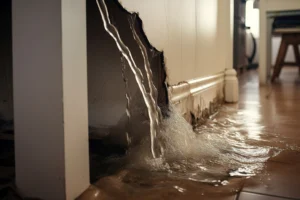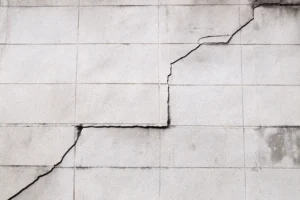
How do you know what the best basement wall repair is for your basement? There are several types of foundation repair methods available and each is designed to solve a specific issue. There are basement walls that are tipping in at the top and basement walls that are bowing in along a horizontal crack.
Then there are foundations that are crumbling or have severe mortar rot. Some basements have settling issues that result in vertical cracks in basement walls or stair-step cracking in the walls. And then there are basement walls that have a sheer break in them resulting in the wall sliding inwards along the break.
DryMaster is here to solve ALL of your basement waterproofing needs including foundation repair services. Whether your current situation is a basement emergency or early signs of water damage, our guide is here to provide insight and DIY fixes to your foundation problems. But ultimately, our team is here to assist you with the larger foundation problems.
Bowing FoundationWalls
As a rule of thumb, basement walls that are bowing in can be reinforced to prevent further movement. Note: up to 2″ of inward bowing or less is required, anything beyond that and your wall is no longer structurally sound and should be replaced.
Some basement walls can be straightened, but only if there are open cracks that have never been filled in. Continuing the thought of straightening bowing basement walls, to do it properly you must excavate the soil away on the outside first to relieve the pressure allowing the wall to go back to its best position.
Walls that have the cracks caulked or filled in will not straighten up. The filler binds the joint and prevents the crack that opened from closing back up which is what straightening the wall is actually doing.
Tipping Foundation Walls
Tipping basement walls are a result of them not being well attached to the structure above during construction. This is a wall that is straight from bottom to top but leaning inward at the top. This is different from bowing as you will not see a horizontal crack that is opened up. Fixing tipping basement walls involves first removing the soil outside to relieve pressure. Then a system of steel beams and screws/jacks are used to slowly push the wall back into its best possible position. The steel beams can be left in place to hold the wall from further movement or other methods can be used to secure the structure above to the foundation to prevent movement.
Steel I-Beams vs. Carbon Fiber Mesh
When small fixes aren’t enough, New Jersey homeowners need to resort to major structural foundation repairs such as installing steel i-beams or a carbon fiber mesh. It’s best to contact the experts when considering the route. This will ensure minimum maintenance in the future and prolonged structural integrity to your home.
Steel I-Beams
Steel I-beams as a basement wall repair method can be used. Steel-I beams are to be buried below the floor and cemented in at the bottom and properly attached to the wood structure above. In this scenario the floor below and the wood structure above is actually holding the I beam in place. Steel beams are straight so they only touch the wall where it is bowed out. The gaps at the top and bottom between the wall and beam should be filled in to prevent the wall from shifting behind the beam.
The downsides are that steel beams are unsightly, can rust, and still can flex. Also if the soil conditions outside push on the wall it can cause the beam to put pressure on the wood structure causing it to shift or twist.
Carbon Fiber Mesh
The latest basement wall repair method for bowing basement walls is carbon fiber mesh “straps” which are embedded into the face of your foundation walls. Modern carbon-fiber mesh manufacturers have developed a system made of both carbon fiber and Kevlar meshed together giving them the ultimate in tensile and shear strength. These systems are smooth to the wall and paintable making them barely noticeable. Carbon fiber / Kevlar mesh straps are embedded into the face of the wall with a two-part epoxy becoming part of the structure. How this method works is that the straps are inflexible or do not stretch, so they create tension on the wall preventing movement. Soil pressure outside is diffused and the wall is permanently stabilized.
New Jerseys Foundation Repair Experts
We are proud to be known as New Jersey’s foundation repair specialists. Established over 30 years ago, Dry Master has created a reputation based on honesty, quality, and fair pricing. All of our basement waterproofing comes with a free lifetime guarantee which is transferable to a new owner at no cost.
Call today to schedule a free evaluation of your foundation, basement waterproofing, or concrete issues, and we will show you why you should rest your foundation on our reputation. We strive to be the best foundation contractors in the New Jersey area.



